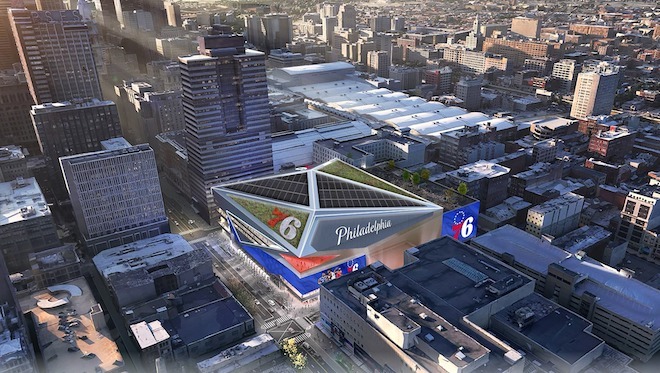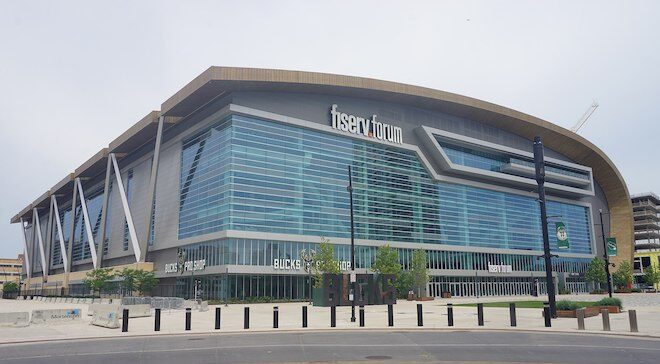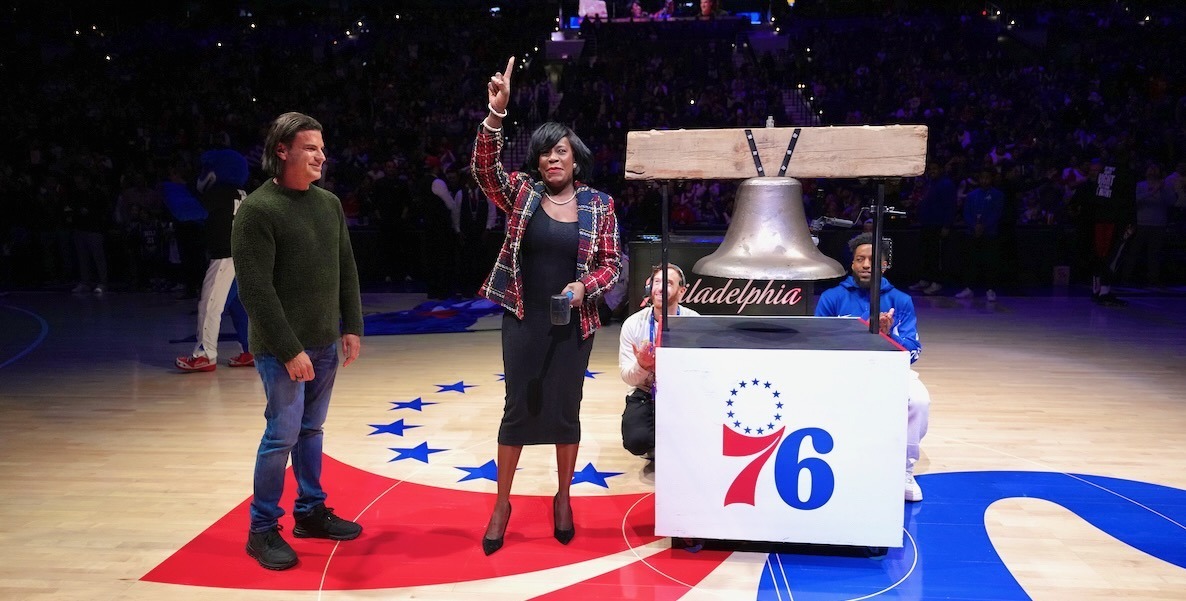It’s hard to knock Mayor Cherelle Parker for how she does public messaging. An adept civic cheerleader, Parker is inspirational, loud and consistent in most of her appearances. Away from the stage, she rarely speaks off the cuff, an approach she teased before taking office.
“I am Black, I am a woman who comes from humble beginnings, and I don’t have the luxury of giving a knee-jerk reaction,” Parker told The Inquirer last fall. “My homework always has to be done.”
There’s one issue, however, where Parker’s comments haven’t been deliberate as much as absent altogether: Her opinion of 76 Place, the Sixers’ $1.55-billion proposed arena in Chinatown.
As Philadelphians, we should have questions about 76 Place. As our mayor, Parker should be able to answer these questions to our satisfaction — preferably within two hours, tonight.
Although Parker has spoken positively of the potential job creation that could stem from the project — a factor cited in the decisions of building trades and Black clergy to support the arena — she has been largely mum on how she’s leaning on the project. Meanwhile, arguments for and against the arena have both gained steam.
A town hall about 76 Place, tonight
That may change tonight at the Convention Center, where Parker will face questions regarding the project for the first time in a public venue. Parker announced the event just a day after thousands of protestors gathered outside City Hall to protest the arena proposal, and roughly two weeks after the city released inconclusive “impact studies” looking at the economic and civic ramifications of the would-be project. (Full disclosure: Both Comcast, owner of the Sixers’ current arena, and Sixers part owner and arena developer David Adelman support The Citizen.)
Now, nearly 26 months after the 76ers first revealed their intentions to develop a swath of Market East and move their home games downtown — and reportedly days before the City will move to approve the plan or not — Parker will likely face a packed and passionate crowd, as has become the norm for the few meetings about the project.

On Monday, opponents of the arena delivered a birthday cake to Mayor Parker which had “Save Chinatown!” written in bright red icing. It’s a sentiment shared by many Philadelphians who’ve come to view the arena as an existential threat to longtime residents of the surrounding area. Meanwhile, 76ers owner Josh Harris has threatened to take his ball and leave — quite literally — by relocating the team to New Jersey, raising the stakes further.
There’s been a need for level-headed leadership from within City Hall to help reframe the conversation about 76 Place — both what the benefits are, potentially, along with the tradeoffs for various constituencies in the city. Here are some of the need-to-know questions that the Parker administration should be tasked with answering:
Who from your administration is leading conversations with 76 Place proponents and opponents to help find a solution that works for everyone?
Why it matters: Parker has been hesitant to comment on the 76ers’ plans, but that doesn’t mean the administration has been sitting around on their hands. Or does it? The truth is, we don’t really know.
The final yes-or-no decision on the arena is almost as important as having transparency about how the city gets there. The public has been left to read between the lines of what the decisive factors will ultimately be, whether it’s the impact studies or otherwise. When it comes to the negotiations that the administration is having with the team and opponents like the Save Chinatown Coalition, has Parker been bringing all sides of this debate to the table? Whom has she tasked with representing the interests of all Philadelphians in the conversations?
If not a basketball arena, does City Hall have an alternative plan to reinvigorate Market East?
Why it matters: Debate over the arena has focused on what will happen — for better or worse — if the project is allowed to move forward. But much less has been made of the opportunity costs of doing nothing. The Fashion District has been a major letdown. What could go there instead?
Comcast Spectacor — the current landlord for the team, who wants to keep them at the Wells Fargo Center — recently floated the idea of transforming Market East into a biomedical hub. But that’s just an idea, without funding at present. Maybe it could become apartments with plazas, like the ones across Market Street? A business improvement district? Would someone please finally open one of those indoor inflatables or amusement parks so Philly families don’t have to drive to Jersey or Oaks for birthday parties?
You can’t blame Chinatown residents for protesting such a major, neighborhood redefining development. Established 150 years ago as a refuge for Chinese immigrants who faced abject discrimination out West, these 10-ish square blocks have, for decades, fallen victim to short-sighted city planning — all in the name of progress. Projects like the Ridge-8th Street subway, the Vine Street Expressway, the Gallery and the PA Convention Center have destroyed hundreds of Chinatown homes and businesses, displacing neighbors — and creating eyesores.
Notably, the arena would be sited not in Chinatown itself, but across the street in Market East, along a two-block strip that’s definitely in need of revitalization. Would an arena help? Are Chinatown’s champions missing the larger picture?
How has the administration tried to shape the Community Benefits Agreement being offered by the 76ers?
Why it matters: When the team initially announced its plans for 76 Place, they proposed giving $50 million to Chinatown for things like traffic control, trash pickup, cultural preservation, and rental assistance for residents and businesses, whose costs may increase as a result of the project. If it materializes, the CBA would be the largest in the history of Philly development.
However, groups like the Save Chinatown Coalition have criticized the CBA as a corporate attempt by the $4.3 billion Sixers organization to buy their support, and questioned the overall impact of the deal. During a town hall last November, one skeptical resident noted that the proposed CBA would pay out over the course of the team’s 30-year lease, leaving “only $1.6 million a year spread across this community.”
NBA teams play 41 home games per year, not including playoffs … What happens at the arena during the other 320-plus days a year?
Here’s another question: Has Parker insisted the Sixers give more money to the neighborhood? Better yet, has she considered other ways the team might benefit Market East and Chinatown — such as the creation of an affordable-housing fund, which was part of a CBA completed by the Los Angeles Clippers in 2018 as part of their arena deal?
Or, could Philly replicate what happened in Milwaukee, where the NBA franchise codified salary increases in its CBA, resulting in a doubling of salaries for arena workers? What we know about a potential CBA comes from the limited details that the Sixers have shared publicly. But if there’s also an opportunity to negotiate for more, will Parker be the one to do it?
For that matter, what models has the City studied to understand how a downtown arena can be done well?
Why it matters: Drawing decisive conclusions from any revenue projections for an arena or stadium is a fool’s errand, according to most sports economists. The economic impact analysis for 76ers Place is no exception. Consultants hired by the team estimated that $1.9 billion in new activity would come from the development, but a separate report, written by an academic from the University of Washington, suggested the city could lose close to a billion dollars in tax revenue. The truth likely lies somewhere in between.
In fact, there are both cautionary tales and surprising success stories for downtown sports arenas across the country. One oft-mentioned example is Capital One Arena in Washington, D.C., where the city’s NBA and NHL teams play. Built in D.C.’s Chinatown, the arena project declared eminent domain, displacing hundreds. Thirty years later, 300 out of 3,000 Chinese-American residents and a handful of Chinese-American businesses remain, with the teams now planning to relocate to nearby Virginia.
There’s also the 50-year-old legacy of Dodgers’ Stadium sited on three displaced Mexican American neighborhoods in Los Angeles — now called Chavez Ravine — whose neighbors were promised, then denied, public housing.

In recent years, the innovation of CBAs has been, for many, a game changer. Consider the Detroit Pistons’ stadium, which brought life to a commercial corridor along with job-training programs and other perks for non-game-goers.
Or Denver’s Coors Field, whose arrival utterly transformed a swath of warehouses and dirt streets into not just a home for a brand-new Major League Baseball franchise, but also a sparkling new neighborhood with condominiums and a year-round entertainment village. To achieve this, Coors Fields’ developers “actively engaged the community during the development process,” and Denver instituted a modest .01 percent sales tax. Today, although the ballpark district itself pays no taxes, its residents have proposed — and will vote on November 5 on — a self-imposed tax to help remedy the current homelessness crisis there.
Which, if any, of these projects is Parker and her administration looking at? Are her people talking to city leaders from other municipalities, either about best practices and what to avoid? It’s essential to understanding the calculus of what ends up happening.
If the 76ers move to New Jersey in lieu of building a new stadium — as they’ve said to be “seriously” considering — what will the consequences be to Philadelphia’s economy and spirit?
Why it matters: Last week, Parker responded to reports that the state of New Jersey is prepared to offer the 76ers more than $900 million in incentives to relocate to the Garden State. “The place for all Philadelphia teams to be is right here in Philadelphia, and that is a priority for me as mayor of this city,” Parker said.
But that’s understating the psychological and financial toll of losing a team. In 1984, the NFL’s Baltimore Colts made the abrupt decision to relocate to Indianapolis after the city’s indecisiveness in offering to pay for a new stadium. It took more than a decade for the city to get another team back. The loss tarnished the reputations of city officials and left the area around the old stadium dormant on Sundays. And now, well, the Ravens are way better than the Colts, but that’s a different story.
Is Parker working with the Sixers to design a plan for 76 Place that benefits the public — even when the team has no game?
Why it matters: NBA teams play 41 home games per year, not including playoffs (though Sixers fans won’t be holding their breath for that). What happens at the arena during the other 320-plus days a year remains an open question — and one that was top of mind for Councilman Mark Squilla when I interviewed him back in February.
“Is the city even able to have two arenas in the city, and will both of them be able to survive and sustain themselves? What are the tax revenue gains? Is it just a swap of revenue from one location to another?” he asked.
Squilla, whose district includes the proposed site, has the power to unilaterally push the arena forward or stop it in its tracks thanks to councilmanic prerogative. But the mayor’s influence can’t be understated. There will likely be concerts and other big events, but with the Wells Fargo Center hosting the Flyers and Wings only, there’s going to be much more competition for crowds. There’s no guarantee that a downtown arena ends up being a net gain for the city.
Can the City insist the Sixers make the ground floor a permanent public space, one that the whole community can use? Will they open the facility on non-game days to youth leagues or art shows, turning it into a multi-use space, like Major League Soccer’s Austin FC’s stadium? Are these out-of-the-box ideas on Parker’s radar at all?
If 76 Place is approved, what will the City do to make sure that at least 40 percent of spectators take the subway to the arena, as the team projects and as the impact reports say is the minimum needed to keep traffic manageable?
Why it matters: One hope for the project is to bring more foot traffic — via subway and regional rail — into Center City. This would be unusual, but arguably not impossible, if the Sixers can spur a dramatic change in behavior. Currently, 75 percent of people drive to games at the Wells Fargo Center.
But a traffic impact study of the arena proposal has suggested that nearby intersections may experience significant delays. The danger of more vehicular traffic in an already commonly snarled section of Center City — don’t even try to drive through Chinatown during the car show or Flower Show — isn’t just an inconvenience to drivers or game-goers looking for parking. Doctors from nearby Jefferson Hospital have independently come forward to express worry about ambulances’ abilities to deliver critical patients to their emergency department in time to save lives. (Jefferson Health has not taken an official stance on the project.)
No matter where you stand on the issue, we can all agree: Moving the Sixers to Center City would be a very big deal. A deal this big engenders a commensurate amount of consideration, because Philadelphia is a big city (that has an unfortunate history of making bigly poor city planning choices over the centuries).
As Philadelphians, we should have questions about 76 Place. As our mayor, Parker should be able to answer these questions to our satisfaction — preferably within two hours, tonight.
![]()
MORE ON SPORTS ARENAS AND ECONOMIES
Philadelphia Mayor Cherelle Parker, rings the bell before the game between the Houston Rockets and the Philadelphia 76ers on January 15, 2024 at the Wells Fargo Center, while 76ers co-owner David Adelman looks on. Photo by Jesse D. Garrabrant/NBAE via Getty Images, courtesy of the Philadelphia 76ers.



